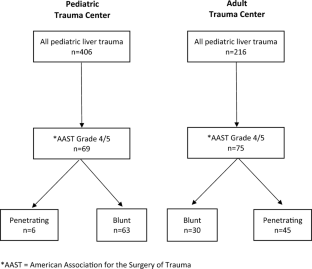Pediatric Surgery International ( IF 1.8 ) Pub Date : 2024-04-07 , DOI: 10.1007/s00383-024-05673-5 Goeto Dantes , Courtney H. Meyer , Maeghan Ciampa , Andreya Antoine , Alison Grise , Valerie L. Dutreuil , Zhulin He , Randi N. Smith , Deepika Koganti , Alexis D. Smith

|
Purpose
Management of high-grade pediatric and adolescent liver trauma can be complex. Studies suggest that variation exists at adult (ATC) vs pediatric trauma centers (PTC); however, there is limited granular comparative data. We sought to describe and compare the management and outcomes of complex pediatric and adolescent liver trauma between a level 1 ATC and two PTCs in a large metropolitan city.
Methods
A retrospective review of pediatric and adolescent (age < 21 years) patients with American Association for the Surgery of Trauma (AAST) Grade 4 and 5 liver injuries managed at an ATC and PTCs between 2016 and 2022 was performed. Demographic, clinical, and outcome data were obtained at the ATC and PTCs. Primary outcomes included rates of operative management and use of interventional radiology (IR). Secondary outcomes included packed red blood cell (pRBC) utilization, intensive care unit (ICU) length of stay (LOS), and hospital LOS.
Results
One hundred forty-four patients were identified, seventy-five at the ATC and sixty-nine at the PTC. The cohort was predominantly black (65.5%) males (63.5%). Six injuries (8.7%) at the PTC and forty-five (60%) injuries at the ATC were penetrating trauma. Comparing only blunt trauma, ATC patients had higher Injury Severity Score (median 37 vs 26) and ages (20 years vs 9 years). ATC patients were more likely to undergo operative management (26.7% vs 11.0%, p = 0.016) and utilized IR more (51.9% vs 4.8%, p < 0.001) compared to the PTC. The patients managed at the ATC required higher rates of pRBC transfusions though not statistically significant (p = 0.06). There were no differences in mortality, ICU, or hospital LOS.
Conclusion
Our retrospective review of high-grade pediatric and adolescent liver trauma demonstrated higher rates of IR and operating room use at the ATC compared to the PTC in the setting of higher Injury Severity Score and age. While the PTC successfully managed > 95% of Grade 4/5 liver injuries non-operatively, prospective data are needed to determine the optimal algorithm for management in the older adolescent population.
Level of evidence
Level IV.
中文翻译:

复杂儿科和青少年肝脏创伤的管理:成人与儿科 1 级创伤中心
目的
高级儿童和青少年肝外伤的治疗可能很复杂。研究表明,成人 (ATC) 与儿童创伤中心 (PTC) 之间存在差异;然而,细粒度的比较数据有限。我们试图描述和比较大城市中 1 级 ATC 和两个 PTC 之间复杂的儿科和青少年肝损伤的处理和结果。
方法
对 2016 年至 2022 年间在 ATC 和 PTC 治疗的美国创伤外科协会 (AAST) 4 级和 5 级肝损伤的儿童和青少年(年龄 < 21 岁)患者进行了回顾性研究。人口统计、临床和结果数据是在 ATC 和 PTC 获得的。主要结局包括手术管理率和介入放射学(IR)的使用率。次要结局包括浓集红细胞 (pRBC) 利用率、重症监护病房 (ICU) 住院时间 (LOS) 和医院 LOS。
结果
已确定 144 名患者,其中 75 名在 ATC,69 名在 PTC。该群体主要是黑人(65.5%)和男性(63.5%)。 PTC 的 6 起伤害 (8.7%) 和 ATC 的 45 起伤害 (60%) 为穿透伤。仅与钝器损伤相比,ATC 患者的损伤严重程度评分(中位数 37 比 26)和年龄(20 岁比 9 岁)更高。 与 PTC 相比,ATC 患者更有可能接受手术治疗(26.7% vs 11.0%,p = 0.016)并且更多地利用 IR(51.9% vs 4.8%,p < 0.001)。在 ATC 管理的患者需要较高的 pRBC 输血率,但没有统计学意义 ( p = 0.06)。死亡率、ICU 或医院住院时间没有差异。
结论
我们对高级儿科和青少年肝损伤的回顾性审查表明,在损伤严重程度评分和年龄较高的情况下,与 PTC 相比,ATC 的 IR 和手术室使用率更高。虽然 PTC 通过非手术方式成功治疗了 95% 以上的 4/5 级肝损伤,但仍需要前瞻性数据来确定老年青少年群体的最佳治疗算法。
证据级别
四级。



























 京公网安备 11010802027423号
京公网安备 11010802027423号